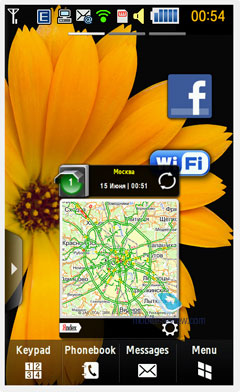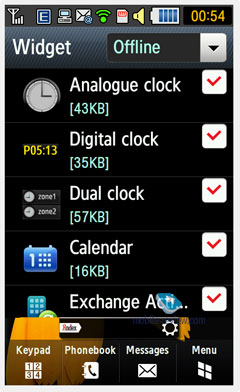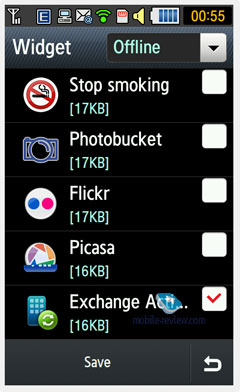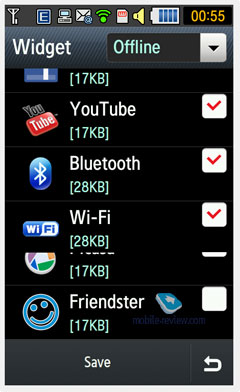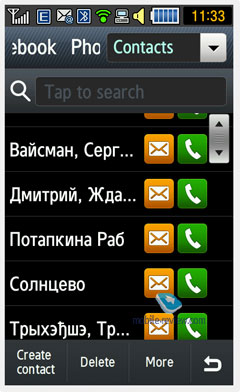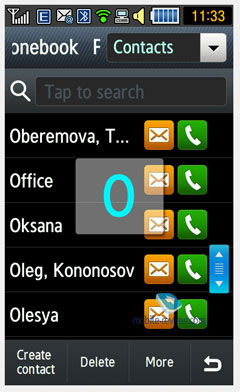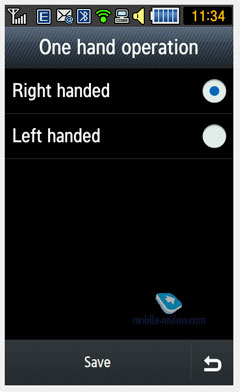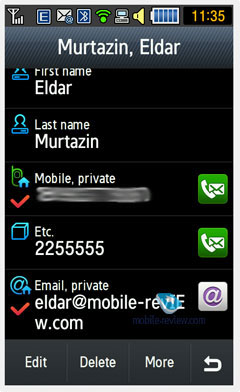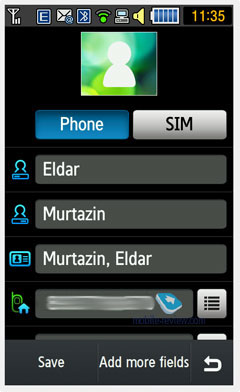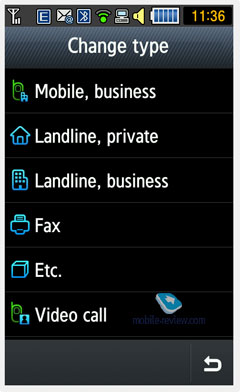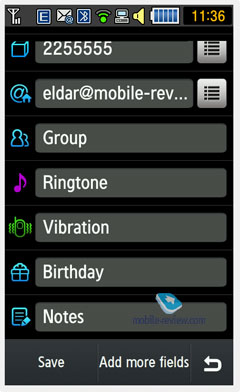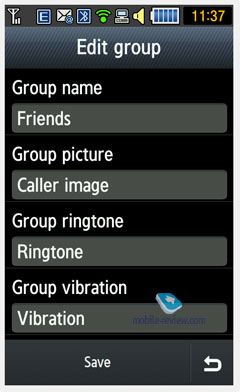|
|
Review of GSM/UMTS-handset Samsung Jet (S8000)
Live images of the Samsung Jet
Table of Contents:
- Positioning
- Design, Size, Controls
- Display
- Battery
- Connectivity
- Memory, Memory cards
- Performance
- Camera
- Motion Gate
- Menu, Interface
- Phonebook
- Call log
- Messaging
- Organizer
- Applications
- Alarm Clock
- File Manager (My files)
- Settings
- ÌÐ3-player
- Picsel Viewer, Photobrowser, Navigation
- Impressions
Sales package:
- Handset
- 1100 mAh Li-Ion battery
- Charger
- Wired stereo-headset
- User Guide
- Software CD
- Carrying case
Positioning
The phone codenamed as Cubic35 was first sketched back in 2008 and originally it was supposed to start a whole family of similarly styled products featuring an additional rotating cube-shaped menu. Weeks before the launch the S8000 got its personal name - Jet. At the same time Samsung decided to release other solutions separately and make a new line-up out of them. One of the most likely reasons is that while the S8000 rates to be the junior model in this range, as far as functionality goes, it's one of the most interesting offerings. It's the first phone to come armed with a 800 MHz CPU, completely revamped user interface, advanced animation effects, webkit-powered browser… And the list goes on. The S8000's codename stems from its UI speed - the company's press-release claims that the phone's CPU can work with applications directly and enjoys parallel architecture. While I can't really make out what they meant, I am going to testify that this phone is one of the fastest devices I've ever used. Coupled with 512 Mb of RAM it leaves many other feature- and smartphones far behind.

Samsung wanted to come up with a touchscreen-enabled phone for the mass-market, in other words give it all the best from two worlds - smartphone-esque functionality and straightforwardness and reliability of a feature phone. Essentially, their primary goal was to conceal all uncalled-for extra features and as it can be seen today, they have coped with it very well. User interfaces will soon become the driving force in the mobile phone market and Samsung will be using the same proprietary solutions across various platforms, which is an extremely strong move that other players won't be able to copy. In fact, over at Samsung they talked about it back in 2006, but never got to implement this approach. Today, however, everything is changing, as a new trend on the market is picking up speed - not only will they camouflage not-so-hot UIs of certain operating systems, but also ditch all default user interfaces in their future products. The Samsung Jet is the company's first step in this direction, even though it's based on Samsung's proprietary OS; it's a reference model, if you like.
Back to the table of contents >>>
Design, Size, Controls
The Jet's key design element is the cube embedded into the center key that looks more or less like a precious stone. Other than that, the Jet utilizes Samsung's typical styling for touchscreen-enabled handsets. Although there are some differences, such as the back cover that is made out of plastic, but features palpable ruby stripes which add a new dimension of class to it.






The Jet's casing is made entirely out of plastic, and many might fault the phone for how it feels in the hand, but in my opinion its more than solid build quality make up for this. Interestingly, while the back cover is a true fingerprint-magnet, the phone's display cover boasts a special coating (similar to that found in the Apple iPhone 3G) that allows it to stay clean and smudgeless.



The phone measures up at 108.8x53.5x11.9 mm and tips our scales at just 100 grams - it's compact enough to readily slip into just about any pocket or purse. Housed on the left is the volume rocker, which on the right there is the display lock switch, camera shutter key and cube activation button. Long-pressing it activates Motion Gate feature (in other words - shake control). Perched on the top end is the 3.5 mm audio jack along with the microUSB socket under a plastic flop. Topping the display are the forward-facing camera for video-conferencing and proximity sensor.

Samsung Jet vs Samsung Omnia HD:


Samsung Jet vs LG Arena:




Back to the table of contents >>>
Display
The Jet employs the last-gen AMOLED display, making it the best offering on this front to date - no other screen can boast the same combination of vibrant colors, resolution, sharpness and contrast. While some phones feature similar display resolutions, they lack in other areas, including color reproduction. The S8000's 3.1-inch display is capable of 480x800 pixel resolution and 16 million colors.

For example the Samsung i8910 HD's screen trumps the Jet in terms of diagonal, but offers lower resolution. In fact, compared to the Samsung Jet, the i8910 screen's only strength is its physical size, while in all other aspects it simply can't stand up to this newcomer.
Samsung Jet vs Samsung i8910 HD:






Samsung Jet vs Nokia 5800 XpressMusic:





Not to mention that it wins head-to-head comparisons with the Nokia N97 and Apple iPhone hands down.
But not only the Samsung Jet's display is a marvel from a technological standpoint, it's also very convenient to use with its automatic brightness adjustment that works considerably better than in the Omnia HD.
All data input is done via this touch-sensitive display, running a brand-new R-Resistive technology that takes all the best traits of both Capacitive and Resistive screens.
All in all, the Jet is handier than its predecessors, for you don't have to tap the screen hard to get a response, and at the same time it allows you to use any object to type, bet it a stylus, a pen or fingernails. Personally, I really like how seamless my texting experience was with this touchscreen.
Samsung-branded offerings also employ the VibeZ feature so as to make the casing vibrate a little, confirming your actions, and we do mean "actions", since it gives you an unobtrusive buzz whenever you tap some action-related keys. The Jet, however, takes this technology to a new level - its feedback feels infinitely better that that of its predecessors.
The display accommodates up to 16 text and 3 service lines, but you can cram as many as 24 lines into it when reading a message, depending on the font size you have picked. The volume rocker lets change the font size, from large to miniscule. It's quite another matter, though, that that unlike most other offerings, the S8000 sports huge-ish font sizes, which are very readable from almost any distance.
While the Jet's display gets washed out under direct sunlight, it remains a tad more readable than TFT-displays.


The phone comes armed with a motion sensor that allows rotating the screen and also scrolling through your galleries by tilting the handset in various directions. Another notable feature found in the S8000 is Smart UnLock, allowing the user to draw a specific letter while at the standby screen that serves as a shortcut to a phone number or an application (up to 9 programmable shortcuts).
Back to the table of contents >>>
Battery
The handset utilizes a 1100 mAh Li-Ion battery, rated for 250 hours of standby and 5 hours of talk time. In Moscow the S8000's battery time averaged around 2 days (a bit over one hour of calls, a couple of messages a day, scheduled email checks every two hours and up to two hours of radio). Those who are into mail and web, will be able to squeeze around a day of life time from the S800. But in general, this handset can stay up and running for 1-2 days hands down. It takes the phone around 2 hours to charge up.

Wireless data transfers are by far the most power-hogging department of the S8000.
Playing non-converted video will drain the phone's battery in 4.5 hours, as for the phone's music time, the Jet's battery will last only 22 hours. While it's not a record-breaker in terms of battery life, the Jet does offer better-than-average battery times in pretty much all modes. On the other hand, if you opt to use it only for calls and messaging, one charge may well last 3-4 days.
Back to the table of contents >>>
Connectivity
Bluetooth. The model supports various profiles, such as Headset, Handsfree, Serial Port, Dial Up Networking, File Transfer, Object Push, Basic Printing, A2DP, SIM Access. EDR-enabled Bluetooth 2.1 is onboard. Wireless headsets are handled by the S8000 with ease.
USB-connection. In the menu you may select one of three modes: Media, Mass Storage, Samsung PC Studio. When connected to a PC via USB, the S8000 automatically recharges itself. While there is no Modem mode, you can easily turn the S8000 into a wireless modem with the help of PC Studio.
While in the USB Mass Storage mode, the S8000 shows up on the desktop without requiring you to install any additional drivers, so right after plugging in it's ready to work. Data connection speeds top out 4.5 Mb /s.
You won't be able to use the S8000's Bluetooth connectivity along with USB - it will require you to disable Bluetooth regardless of its status (connected and transferring data or not), which is very awkward.
There is also EDGE class 10 connectivity for GSM networks.
WiFi. The phone supports 802x11 b/g standard and features a setup wizard similar to that used for Bluetooth connections. The Jets allows for storing selected networks and tapping into them on request. The only downside we've come across over our quality time with the phone is that some public networks require authentication, and without a SIM card the Jet fails to pass this procedure.
Back to the table of contents >>>
Memory, Memory cards
The phone ships with 2 Gb of onboard memory and 1.5 Gb, give or take, will be available to the user right out of the box. The memory card is displayed as a separate section, but you can also view both memory card and internal storage at the same time. The S8000 also comes with a file manager, enabling you to copy files to/from the memory card. During our tests the handset experienced no problems with a 32 Gb microSD memory card.
Back to the table of contents >>>
Performance
With its 800 MHz CPU and boatloads of memory, the Jet is easily one of the top performing phones these days.




Camera
The S8000 comes equipped with a bog-standard 5 Mpix autofocus camera module. The phone enjoys a landscape camera interface and allows the user to tweak all settings and change options on the fly by simply tapping on thumbnails you need right on the screen. Needless to say, this makes the phone's camera app a breeze to work with.

Resolutions:
- 2560x1920
- 2048x1536
- 1600x1200
- 1280x960
- 640x480
- 2560x1536
- 1600x960
- 800x480



Shooting modes:
- Single shot
- Multi-shot
- Panorama shot
- Smile shot
- Mosaic
- Frame
White balance:
- Auto
- Daylight
- Incandescent
- Fluorescent
- Cloudy
Effects:
- Black and white
- Sepia
- Negative
Scenes:
- Portrait
- Landscape
- Sports
- Indoor
- Beach
- Sunset
- Dawn
- Waves and snow
- Night shot
- Against light
- Fireworks
- Text

As far unusual features go, we can't overlook the Jet's Face Detection that allows the phone's camera to focus on people's faces while shooting, plus Samsung have tweaked it a little bit, so that now you can make the camera take another picture a few moments later if it thinks that the person it's focus on has blinked.



We won't review geo-tagging, contrast, brightness and sharpness settings, for these are all bog-standard features in any contemporary handset.
 |
 |
| (+) enlarge, 2560x1920, JPEG |
(+) enlarge, 2560x1920, JPEG |
 |
 |
| (+) enlarge, 2560x1920, JPEG |
(+) enlarge, 2560x1920, JPEG |
 |
 |
| (+) enlarge, 2560x1920, JPEG |
(+) enlarge, 2560x1920, JPEG |
 |
 |
| (+) enlarge, 2560x1920, JPEG |
(+) enlarge, 2560x1920, JPEG |
 |
 |
| (+) enlarge, 2560x1920, JPEG |
(+) enlarge, 2560x1920, JPEG |
 |
 |
| (+) enlarge, 2560x1920, JPEG |
(+) enlarge, 2560x1920, JPEG |
 |
 |
| (+) enlarge, 2560x1920, JPEG |
(+) enlarge, 2560x1920, JPEG |
 |
 |
| (+) enlarge, 2560x1920, JPEG |
(+) enlarge, 2560x1920, JPEG |
 |
 |
| (+) enlarge, 2560x1920, JPEG |
(+) enlarge, 2560x1920, JPEG |
 |
 |
| (+) enlarge, 2560x1920, JPEG |
(+) enlarge, 2560x1920, JPEG |
 |
 |
| (+) enlarge, 2560x1920, JPEG |
(+) enlarge, 2560x1920, JPEG |
 |
 |
| (+) enlarge, 2560x1920, JPEG |
(+) enlarge, 2560x1920, JPEG |
 |
 |
| (+) enlarge, 2560x1920, JPEG |
(+) enlarge, 2560x1920, JPEG |
 |
 |
| (+) enlarge, 2560x1920, JPEG |
(+) enlarge, 2560x1920, JPEG |
 |
 |
| (+) enlarge, 2560x1920, JPEG |
(+) enlarge, 2560x1920, JPEG |
 |
 |
| (+) enlarge, 2560x1920, JPEG |
(+) enlarge, 2560x1920, JPEG |
 |
 |
| (+) enlarge, 2560x1920, JPEG |
(+) enlarge, 2560x1920, JPEG |
 |
 |
| (+) enlarge, 2560x1920, JPEG |
(+) enlarge, 2560x1920, JPEG |
Samsung Jet Nokia N97:
 |
 |
| (+) enlarge, 2560x1920, JPEG |
(+) enlarge, 1944x2592, JPEG |
 |
 |
| (+) enlarge, 2560x1920, JPEG |
(+) enlarge, 2592x1944, JPEG |
 |
 |
| (+) enlarge, 2560x1920, JPEG |
(+) enlarge, 2592x1944, JPEG |
 |
 |
| (+) enlarge, 2560x1920, JPEG |
(+) enlarge, 2592x1944, JPEG |
 |
 |
| (+) enlarge, 2560x1920, JPEG |
(+) enlarge, 2592x1944, JPEG |
 |
 |
| (+) enlarge, 2560x1920, JPEG |
(+) enlarge, 2592x1944, JPEG |
 |
 |
| (+) enlarge, 2560x1920, JPEG |
(+) enlarge, 2592x1944, JPEG |
Video
The handset records video in mpeg4 format (also there is an option to disable the sound recording in the camera's menu). All the settings here aren't too much different from the single shot mode, except for new resolutions and a bunch of effects. Maximum resolution - 720x480 pixels (15 FPS) or 640x480 pixels (30 FPS). Video quality wise the S8000 is an average performer by contemporary standards.








Back to the table of contents >>>
Motion Gate
The Jet is one of Samsung's first phones to feature a full-fledged motion recognition engine, activated by tapping the side-mounted key. Basically, it allows the user to move around the phone, scroll through tracks in playlists and pause playback by tapping, flipping and shaking the phone. Furthermore, the engine works in a variety of applications, including the FM radio, music player, camera app (tap on the casing to take a picture), games and speed dialing; also the motion recognition engine is contextual, meaning that the roster of movements it can read depends on the application you are currently using. For example while at the standby screen it allows you to launch two different applications by tilting the phone left or right respectively.
Etiquette - if you're receiving a call, or an alarm has just triggered off, all you need to do to mute the sound is turn the phone face down, and doing so won't alter the Jet's current profile.
Speakerphone mode - you can program the Jet in a way that as soon as you put it on a flat surface it'll switch to the speakerphone mode (provided that you're in a call).
On top of that the Jet comes with a multimedia guide on how to control thephone with gestures - they are extremely easy to learn and after a couple of hours even a child will master all of them.
Back to the table of contents >>>
Menu, User Interface
As we already know, Samsung have made their TouchWiz a cross-platform interface, meaning that it can be found both on the phones running Samsung's proprietary OS, and Symbian, Windows Mobile, Android based handsets. However originally TouchWiz was designed for their own OS, hence its vast functionality on this platform, as well as the speed at which all new features get to it. In this sense, the Jet is the world's frist phone to sport a revamped TouchWiz user interface, and in fact it's one of the most exciting offerings out there.
In my review of the Samsung i8910 INNOV8 I wrote that Samsung had already developed a "cube", each of whose facets launched certain applications and that this solution would be most applicable in touchscreen-enabled devices. However at the end of the day LG, with their Arena, beat them to the market, and surprisingly, one of the touted features in it was the cube-shaped user interface. The brand-new Samsung Jet also sports an astonishingly similar UI, launched with a press of the side-mounted key. But when you take a closer look at it, turns out, the Jet's "cube" is in fact better. Its facets show not only some predefined pictures, but instead dynamically changing images that depend on what's stored on the phone at the moment (and include album covers, images, video etc). The cube can be rotated in any direction and boasts extremely smooth animation. Plus there is a toolbar with shortcuts to certain applications, although these are hardwired and there is no way you can change this roster. As you might have already guessed, the shortcuts lead to different facets of the cube.

But much like the LG Arena, the cube here is a nice makeweight, rather than a key element of the interface. And I'm not sure whether introducing another way of performing the same actions and getting to the same menus is a sound idea - many struggle with the fact that they will actually need to press a separate button to call it up and then spin it to the right facet. So I doubt the "cube" UI will become very popular. Serving as a proof to this guess of mine is Nokia's experience with their Nseries devices, where they ditched the multimedia menu a long time ago for exactly the same reason.
Standard Menu
While at the standby screen, the display's base is occupied by a bar containing four shortcuts to the dialing screen, phonebook, messages and menu. On the left is an arrow, tapping which will expand the applications bar, allowing you to drag any Widgets to the screen (their layout is also adjustable). Obviously, the S8000 looks so much nicer with only a handful of windows tacked on, rather than a cacophony of widgets all around its real estate. Let's take a look at what things you can be up on the screen:
- Carrier name
- Date and time
- Analog clock
- Digital clock
- World time (for any chosen city)
- Player controls
- Radio controls
- Album with thumbnails (you can also scroll through images with it)
- Games shortcut
- Events (missed calls, SMS)
- Birthday reminder
- Profile switcher
- Five favorite contacts – you can call them or send SMS, all in one touch
- Mirror – uses the forward-facing camera to show what’s going on right on the screen
- Google search
- Quick access to Samsung’s Fun Club
- Alarm Clocks
- AccuWeather forecast – somewhat similar to the visual effects found in HTC’s Touch Diamond
- Stop Smoking – counts how many days you haven’t smoked
- Stop diet – counts how many days you’ve been on a diet
- Widget uploader
It's easy to see that Samsung's Widgets allow the user to tune and tailor the display's layout to his/her own liking. Unfortunately, sooner or later you will run into the only real limitation of the S8000 in this department - physical size of the screen; naturally, we'd like to be able to cram more elements into it. But, it is what it is today, even in this state Widgets is the most flexible solution out there and it's definitely ahead of Nokia's Active Standby.
The S8000 boasts almost twenty widgets, along with a download manager that enables the user to upload new ones from Samsung's web site. Needless to say that no other phone maker can offer anything even remotely as flexible as the S8000's standby screen.
There are three screens available for filling in with widgets, which you can jump between by sweeping your fingers across the screen.
You can enter the main menu by pressing the icon at the bottomof the screen. The main menu is displayed as a 3x4 grid. The touch-sensitive display is easy to handle - you tap the item you need, then bring up a data input field by double-pressing it, since the first one will select it, and the next one will enabled the on-screen keypad. If the phone is slid open, the user is offered to used the hardware buttons, otherwise the only way to go is the S8000's on-screen keypad.
The main menu is also housed on three screens, which you will have to list through.
All texting is done via the on-screen keyboard, which is almost identical to that of conventional looking handsets - it houses twelve buttons with a batch of symbols attached to each (plus the Jet sports handwriting recognition), so in order to type some particular letter you will need to tap one of these buttons sequentially. On top of that it packs in a QWERTY-keyboard, which is a breeze to use even singlehandedly.


Another thing that has gone through a major revamp is the predictive input system T9. You can enable it both for the numberpad in one touch. The good thing about the S8000 is that it tries to predict what letters or words you will punch in next and therefore makes it a lot easier to pick word endings by simply tapping on them.
All applications feature a context-sensitive tool bar at the foot of the screen.
Another area where the S8000 improves over its predecessors is scrolling - sliding your finger down on the left will make lists scroll through much faster than if you were doing that on the right. In case the list you are browsing features names, you can always opt to jump straight to some particular letter, like in the gallery.
Multitasking. The way multitasking functionality is implemented in the Jet is nothing out of the ordinary - pressing and holding the central button will call up the list of all currently running apps, allowing you to switch between them (they can be viewed as thumbnails or a 3D menu - it's your call). Plus it lets you close all applications or only some. The only limitation we've come across on this front is that the Jet's browser and camera can't work simultaneously.
>
 |
 |
Back to the table of contents >>>
Phonebook
You can call up the phonebook by tapping the shortcut at the standby screen; you will see a list that contains all entries from both the SIM-card and phone's memory. On the left there is a magnifier-shaped shortcut that allows scrolling all the way down to the letter you need. The drop-down list in the top right corner allows sorting the list by entry types - contacts, groups or favorites.
The only view available for the phonebook is a plain list with contact names - you won't be able to browse assigned images or phone number right there, to do that you will have to enter the detailed view.
You can assign any image, photo or video clips as caller ID. Each entry can have up to 5 phone numbers of different types (mobile, office, home, fax, and other), one of them will be the main number (by default it is the first one you entered). All fields are customizable.
There are two lines for First Name and Last Name (search is performed only by the former), these fields get merged when displayed in the general list, and First Name comes first. For example Eldar Murtazin will be shown only in this order. The length of each field is 20 characters for any supported input language. You can also switch languages on the fly when entering a name.
All entries, regardless of language, are sorted out in the following way - all contacts with headings made in a local language (Russian, for example) go first and then those with names in English. This is a rather convenient and handy list sorting system. Taking into account fast language switch option during the search, it's clear that no language will spoil the experience of working with this phone. The list can be sorted by first or last name.
But let us return to the information entered for a contact. Apart from phone numbers, e-mail address (there may be several of them), a little text memo can be submitted on top of all that. Any music file (including MP3) can be picked as a ring tone for a contact. Three caller groups are provided by default with the possibility for creating any number of additional groups, setting a personal melody and image for each (by default there are three groups). SMS alerts are not customizable.
The phonebook is capable of holding up to 2000 contacts with filled in data fields. Even if all the available blanks are not used, the cap won't get any bigger and will still make two thousands. It is possible to specify in the settings where all new numbers should be kept by default. There is also an option for moving entries from the SIM-card, although the reverse action is denied. According to the developers, PC (MS Outlook in particular) is best for data synchronization with the S8000. Any contact in the form of SMS/MMS, mail message or other text file can be quickly sent through Bluetooth to another device. There are no problems with sending, and the phonebook entry gets beamed to another device, where it is read without any trouble.
The phonebook may contain a business card as well, though its structure copies all the fields found in a regular contact in the phone book.
There can be up to twelve numbers in the fast dial list; separate numbers tied up with a single contact may appear on this list as well.
You can create any number of caller groups, assign up to 20 contacts and customize them with a picture and tune.
On an incoming call, the caller ID picture occupies half of the screen, but that doesn't make indiscernible.
Back to the table of contents >>>
Call log
Every list contains up to 30 phone numbers, plus there is a combined list of last calls, SMS messages and emails (up to 90 entries total) with corresponding icons indicating event types. In my opinion, however, the addition of emails makes the list much harder to read if you get dozens of letters every hour, which push all other events to the bottom.
You can quickly switch between the lists. The date and time of any call can be seen in the extended view. Calls from/to one number are grouped up, so that the number standing next to the call specifies the total number of calls made. As always, the overall time of the calls and their cost can be viewed in this menu (if this service is enabled, that is).
For certain numbers you can arrange a black list that will reject all calls coming from these contacts.
Also there is a separate list for sent messages.
Back to the table of contents >>>
Messaging
Much like other makers, over at Samsung they have forgone that artificial division into SMS-MMS types - you just start composing a message, and only then, depending on the contents, it is attributed to SMS or MMS. The menu still holds an option for switching message into MMS mode (for example when you need to send only text, but to an e-mail address, without calling up the bundled client).
The phone memory can hold up to as many as 500 messages; the handset supports EMS standard compatible with Nokia Smart Messaging. While choosing recipient, you can either select a telephone number from your contacts, or pick one from the call lists or groups. All messages are manageable, this means you are at liberty to move a certain number to your black list, in order to make sure all messages coming from that phone number will be deleted automatically; possibility for moving messages to any folder of your own is also at your disposal. For e-mail, you can move not only addresses to the blacklist, but unwanted subjects as well.
There are no size restrictions as far as received messages go, though an outgoing message's size is limited to 295 KB. As for additional services available with the S8000, message rejection and message retrieval type options are onboard. All messages are stored in general dynamic memory, the same goes for e-mails.
Also there is a useful function for sending SOS-messages – when activated, should you find yourself in an emergency, after pressing the volume key four times, the message «I am in emergency. Please help me» will be sent to contacts submitted earlier, all incoming calls from these numbers upon sending the emergency message will be picked up automatically. Recipients (not more than 5), as well as the number of Repeats may be set up manually, while the text of the SOS-message is not customizable.

The bundled mail client is standard in all its components - 5 accounts and the maximum of 100 incoming messages; attachments are also handled by the phone, though there are also several caps - there's no way you can receive a file more than 1 Mb big, or send one with size exceeding 1 Mb. Received files can be viewed via the bundled browser. The S8000 doesn't support HTML in e-mails, which breaks formatting of most letters you receive, so they become really awkward to read.

Also, the S8000 features a setup wizard for the mail application that will walk you through all essential options and settings.
Back to the table of contents >>>
Organizer
The phone's memory can store as many as 300 events of one type - meeting. Also there can be up to 100 "Anniversaries". Day and time as well as end time of an event are indicated for each entry. Alert signal and its duration can be adjusted to your liking; repeatable events are available for setting up (repeat time is also manageable as well as the exceptions). The week and the month calendar views are very convenient with each type of the event having its own color.
Unfortunately, you can't start setting up an even by tapping on some day in the Calendar; plus the S8000 doesn't show three upcoming events for any selected day in the Month view.

Memo – standard text notes.
Tasks – a to-do list allowing you to set different priorities and adjust alarms for up to 100 tasks.

World time is displayed for two chosen cities.
Calculator – It divides, multiplies, subtracts and adds and does several more things - quite enough for a mobile calculator.

With the Converter – you can operate with different units of measurements as well as with a number of currencies.
Back to the table of contents >>>
Applications
FM-radio. You can store up to 99 radio stations in the memory; the range of available frequencies is 87.5-108 MHz. Also, you can enjoy auto-tuning, but particular channels cannot have own names attached - they are always shown as frequencies. The radio implementation is fine, although it doesn't pick up all stations equally well, but on balance, it is quite competent in comparison to other vendors' offerings. The radio can be minimized.
The Jet's RDS not only shows the current station's name at the top, but also other station-related information. On top of that, the phone allows recording broadcasts into its internal memory.

Voice recorder.. You can record up to several hours of voice memos with the number of files being unlimited. Basically, limitations on recording duration are set by the user himself, though length of a single recording cannot exceed 1 hour. All the files are stored in a separate folder in the memory bank. The recorder performs well during lectures, conferences and presentations - I could even say that it is a partial substitute for a digital tape recorder.

Countdown timer and Stopwatch have no bells and whistles.
Bluetooth. As far as this app's outfit goes, it has definitely been reworked thoroughly in the S8000 - now you can view the device map (like in some wireless managers on desktops) or opt to browser the standard version of device list. In terms of Bluetooth, the S8000 is a full-spec solution that won't let you down.

Games. The S8000 supports multitasking for Java applications, meaning that you can fire up a couple of programs, minimize them and bring them back to the top whenever you please. The games pool may vary by market.

Communities (formerly known as Share Pix) – this utility will soon become a part of the default feature pack in many Samsung-branded phones. It allows setting up an account with one of image-sharing services, so as to make the phone tag and send all your images there without your help.

Google. This menu features Google search, Gmail and Google Maps applications. Let's start with the latter - there are no bells and whistles in the S8000's version of these maps, however its 3.2-inch diagonal does make scrolling through them a much more gratifying experience. On top of that you can jump between satellite and street views. The phone pinpointed our location via cellular networks without any problems, so all in all, we have no gripes with this department.

Browser. The Jet is Samsung's first device to boast Samsung mobile 1.0 browser, built on webkit, much like the browsers found in Nokia's and Apple's phones. And the differences from the old NetFront are vast - having kept the basics intact, Samsung have added a handful of unique features. For example, now it allows the user to adjust the display brightness without leaving the application (which is a wonderful ability to have when browsing on the street). On top of that it supports Flash, meaning that you will never run into any problems with pretty much any web page, and since it also have a banner filter, it'll make sure that your browsing experience won't be interrupted by flamboyant ads. By the way, we have checked this feature on a couple of sites and I can say that it's quite efficient.
Among all other things, the browser supports JavaScript, font scaling (three font types), tabbed browsing and full-fledged search. All in all, this is one speedy and easy-to-use browser; although it's still inferior to that of the Apple iPhone, but I'd say it's on a par with Nokia's browser app for S60. It's a move in the right direction for Samsung - we'll see how fast they be developing this browser, but as of today it's one of the finest solutions for this type of phones. On top of that, RSS is now an integral part of the browser.
While uploading your news feed, the S8000 can upload text, as well as video and audio files, and it is up to you to set the size limit (by default - 5 Mb per file). Regrettably, there no scheduled feed updates are available, thus you will need to refresh the feed manually every time you need hot news.






Back to the table of contents >>>
Alarm Clock
You can set up a number of alarm clocks in one touch or enable/disable the ones you have already created. Every alarm is fully customizable - you can pick any day you want and also use a custom tune.

Back to the table of contents >>>
File Manager (My files)
That's the place to search for all files such as music, pictures, video and sounds. Any uploaded file gets stored here. The disadvantage is that files sometimes are not displayed in the list immediately - in that case you will need to leave the menu and enter it again.
Files and folders can be viewed either as a list or thumbnails. You can mark any number of files. The handset supports Move, Copy and Delete operations, as well as various types of sorting (by type, name or size).

Back to the table of contents >>>
Settings
Traditionally this item boasts a standard set of options inside like password protection of selected sections. No special or quaint settings are available with the S8000. It only comes with an assortment of wallpapers and the ability to swap them randomly. The S8000 comes preloaded with profiles enabling the user to change the settings momentarily.

The font size, as well as its color and style are also adjustable.
The user can also modify vibration power for the VibeZ.
The Jet supports TV Out.
Mobile Tracker – submit a phone number, where notifications will be sent to in case SIM-card was changed - that message will contain number of the SIM-card being used with the handset. This section is protected with password, so that no one other than you or someone else who knows the password could disable the Tracker. Should your device have the SIM-card switched once, the specified number will receive one message instantly, and one more each time a new card is plugged in. A fetching feature which can prove to be of much help in case the handset is lost or stolen.

Back to the table of contents >>>
ÌÐ3-player
The S8000 comes with is a typical latest-gen Samsung player. At least that's what it appears to be. The integrated mp3 player, supports random, sequential and cyclic playback. Mp3 files can be uploaded onto the handset both directly over Bluetooth and through the sync application or Windows Media Player. There are no limitations on tags and names of music files. Bitrates are not something that really matters either - the handset easily deals with all available formats and supports WMA, AAC, eAAC, eAAC+.
The title of the currently played back track is displayed as well as the number of the remaining tracks. There is an equalizer is embedded in the S8000, but no way to tune it. Your tracks can be played through the stereo headset as well as the speakerphone. The volume bar has 14 scales on it. And of course the user can make up their own playlists. The player can work in minimized mode - in this case the display will show current track title and music controls, which is a good thing.
The player boasts the following filters: all tracks, recently played, most popular, artists, albums, genres and composers. Filters may be edited in the Settings menu (so that they'll take account of some particular options). The S8000 also sports Album Arts support. If you turn the phone, it'll snap into the Cover Flow mode, similar to that found in the Apple iPhone.
While at the standby screen, if you have the music player minimized, you will see its controls and current track title right on the display.
While in the speakerphone mode, the S8000 was not the best performer we had seen - it played somewhat distorted sound and obviously lacked power, even though the sound didn't feel muffled.
The Jet comes with 5.1 Surround mode for listening to music through a headset, which is similar to Dolby Mobile both in the way it works and what it does to music.
Find Music (formerly known as Music Recognition) – a mere alternative to Sony Ericsson's Track ID service. The gist of this service is this: you record a short clip from some music track you fancy and then the phone finds you its title and artist.

Back to the table of contents >>>
Picsel Viewer
Putting it short, Picsel Viewer is an application that opens MS Office files (for instance, MS Word, Excel, PowerPoint), Adobe Acrobat (PDF), picture and video formats on the phone. The attraction of this technology is its speed, when a 20 MB PDF file takes a couple of seconds to open, then you can quickly page through it, zoom in/out and rotate pages. No editing abilities here, only viewing is available with the S8300, but that is pretty much enough already, especially considering there is no need in extra conversions.
Photobrowser. Another way of viewing images. This browser supports filters by date, color and so on. Plus it allows paging through pictures by tilting the phone; also there are the slide-show mode and bundled image editor.
The Samsung Jet is one of the first phones to support zooming in/out with only one finger, in fact this feature also works in the browser - just tap and hold on the screen to zoom in, and that's it. Of course it's still not multitouch, but an intuitive and simple feature nonetheless.



Navigation. For this department the Jet employs Navifon's app, which is a standard turn-by-turn navigation application, featuring voice guided navigation and so on. While it has got the basics covered, it's not very interesting - I doubt many will be eager to shell out for the full version of the program, and on top of that most users of this phone won't view navigation as the primary focus of this handset.
Photocontacts. This menu is all another way of dialing phone numbers - basically, you add some images and bind them to certain contacts. This app can be brought up from the phone's home screen, which has clearly been inspired by HTC's user interface.
Video editor. This editor is a standard Samsung fare - it allows you to add a couple of sound tracks, video and subtitles. Not particularly useful.

Dynamic Canvas. A plain image editor that lets you save flash images that will show you all strokes you made while drawing.

Synchronization. The Jet supports New PC Studio, meaning that effectively it allows the user to synch pretty much all its contents with a PC. Plus it boasts support for Microsoft Exchange.
Back to the table of contents >>>
Impressions
We were content with the S8000's reception quality, although it wasn't much different from other phones in this class. The ring tones volume was pretty average, and we even missed some calls when the phone was stuffed in a bag. The vibro alert was nothing to shout about either, as it hadn't changed at all, compared to the S5600.
I'm already anticipating an avalanche of forum posts and debates as to what type of phone the Samsung Jet really is. Some will deem it not smart enough for a "smartphone", others will blame it for not having a metal casing. I, for one, have already made up my mind about the Jet. It comes with a very unique interface powered by Touch Wiz 2, which is more of an advantage. As far as its functionality goes, the Jet is jam-packed with features (plus it's the first feature phone to sport MS Exchange support), and while there are some rough spots here and there, they won't bother you too much. My attitude towards this phone has changed from indifference to affection by the end of the first week and now I can't imagine my routine without it. I think you'll agree that not every phone can get to me like that.
Going for the Jet are its well laid-out keyboard, decent tactile feedback, menus brimming with animation and some minor feature Samsung have borrowed from other phone makers. While some products appear to be Frankenstein of a phone with numerous incompatible ideas stuffed into them, the Samsung Jet is different. It's an independent offering with a whole array of offbeat solutions under its belt that sometimes resemble features found in other phones. For example, the album art mode is reminiscent of the Apple iPhone, whereas the contacts grid is similar to that found in HTC's proprietary UI, but at the same time all these feats manage to get along very well within Jet's interface. "Balanced" would probably be the best word to describe this phone.
Also, it's extremely challenging to find any rivals for the Samsung Jet, for it is in a league of its own, and software-wise represents another step forward for Samsung. Essentially, from this point on, Samsung will start implementing the same UI and consequently similar user experience across various platforms. As far as other touchscreen-enabled devices (except for smartphones) go, the Jet is second to none.
Retailing for 645 USD, the Samsung Jet isn't the most affordable device we've seen, but it's not overly expensive either. It's not a mass-market offering, though, but rather a niche device whose major selling points are its marvelous display, novel software and a couple of small, but useful feats. If you are in the market for a feature-rich touchscreen-enabled phone (whose main focus isn't navigation or smartphone functionality), then the Jet might turn out to be just right for you. There is something seductive about it, and I believe it has got what it takes to become a best-seller in its class. Those of you who are about to reach for their wallets will be pleased to know that the Jet is set to land on most markets early in July.
Wrapping it all up, I'd like to say that it's one of the most interesting phones in 2009, and arguably one of the finest touchscreen-enabled devices to day.
Back to the table of contents >>>
Eldar Murtazin ([email protected])
Translated by Oleg Kononosov ([email protected])
Published — 15 June 2009
Have something to add?! Write us... [email protected]
|
News:
[ 31-07 16:21 ]Sir Jony Ive: Apple Isn't In It For The Money
[ 31-07 13:34 ]Video: Nokia Designer Interviews
[ 31-07 13:10 ]RIM To Layoff 3,000 More Employees
[ 30-07 20:59 ]Video: iPhone 5 Housing Shown Off
[ 30-07 19:12 ]Android Fortunes Decline In U.S.
[ 25-07 16:18 ]Why Apple Is Suing Samsung?
[ 25-07 15:53 ]A Few Choice Quotes About Apple ... By Samsung
[ 23-07 20:25 ]Russian iOS Hacker Calls It A Day
[ 23-07 17:40 ]Video: It's Still Not Out, But Galaxy Note 10.1 Gets An Ad
[ 19-07 19:10 ]Another Loss For Nokia: $1 Billion Down In Q2
[ 19-07 17:22 ]British Judge Orders Apple To Run Ads Saying Samsung Did Not Copy Them
[ 19-07 16:57 ]iPhone 5 To Feature Nano-SIM Cards
[ 18-07 14:20 ]What The iPad Could Have Looked Like ...
[ 18-07 13:25 ]App Store Hack Is Still Going Strong Despite Apple's Best Efforts
[ 13-07 12:34 ]Infographic: The (Hypothetical) Sale Of RIM
[ 13-07 11:10 ]Video: iPhone Hacker Makes In-App Purchases Free
[ 12-07 19:50 ]iPhone 5 Images Leak Again
[ 12-07 17:51 ]Android Takes 50%+ Of U.S. And Europe
[ 11-07 16:02 ]Apple Involved In 60% Of Patent Suits
[ 11-07 13:14 ]Video: Kindle Fire Gets A Jelly Bean
Subscribe
|




























































































































